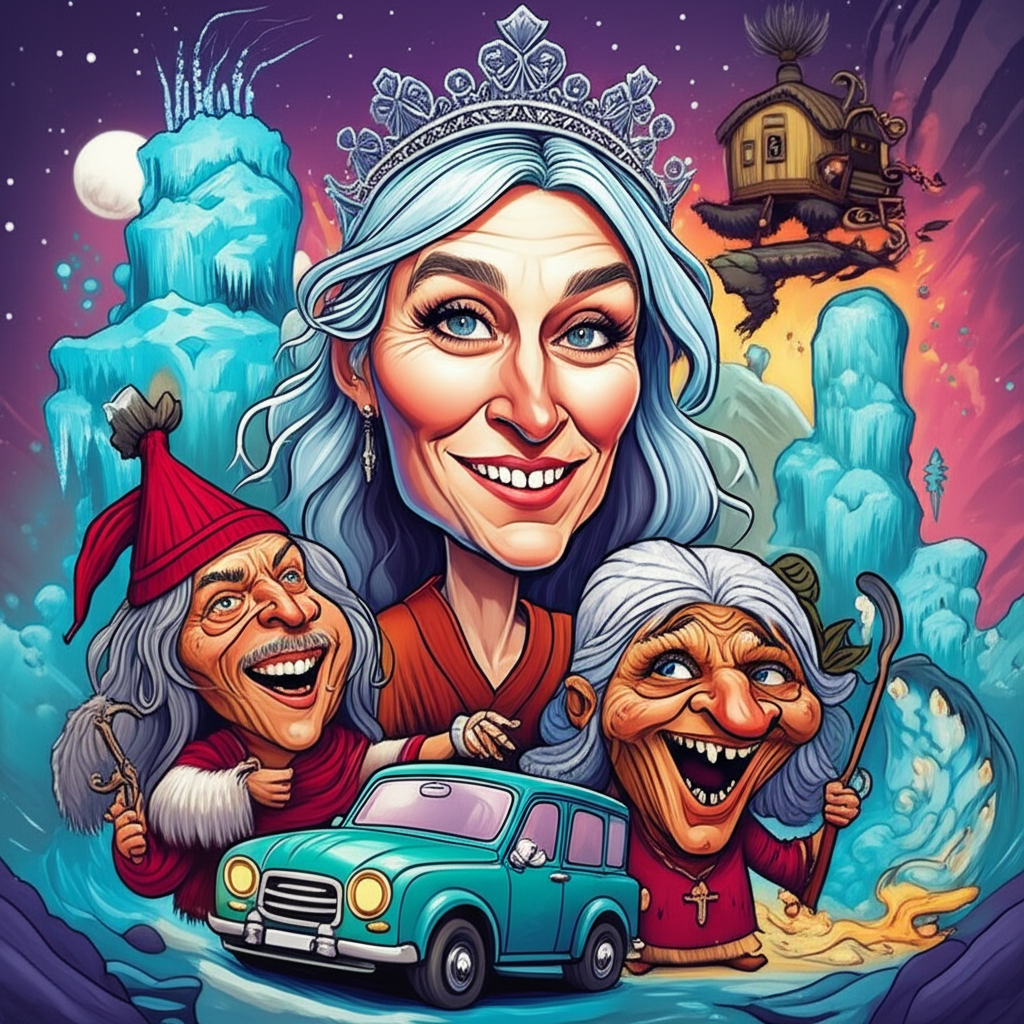
From the deep, shadowed forests and the wind-swept steppes of Eastern Slavic folklore emerges a figure as ancient and enduring as the land itself: Baba Yaga. This narrative delves into the origins, the imagery, and the enduring resonance of this complex figure, exploring how ancient peoples perceived the world and the stories they wove to understand its mysteries. It is crucial to remember that these are traditional tales, born from the imagination and cultural understanding of past societies, offering us a glimpse into their worldview, not a depiction of reality.
Origins and Cultural Background: Whispers from the Old World
The tales of Baba Yaga are deeply rooted in the pre-Christian Slavic world, a time when the natural world held a profound and often formidable power over human lives. Imagine scattered settlements nestled between vast, untamed forests, where the seasons dictated survival, and the rhythms of the earth were paramount. In this environment, life was a constant negotiation with nature’s bounty and its ferocity. The ancient Slavs, like many early cultures, attributed agency and spirit to the trees, the rivers, the very earth beneath their feet. Their worldview was animistic, seeing life and consciousness in all things.
This was a world where harsh winters could bring famine, where unpredictable storms could destroy crops, and where the vast, dark forests were both a source of sustenance and a realm of unknown dangers. Their stories, therefore, often reflected these anxieties and their attempts to make sense of the untamed forces around them. Myths and legends served as a framework for understanding the cycles of life and death, the balance of creation and destruction, and the inherent duality of existence. Baba Yaga, in her various manifestations, embodies many of these primal fears and fascinations.
Character/Creature Description: The Crone of the Forest
Baba Yaga is not a single, static entity but a multifaceted figure who defies simple categorization. She is most often depicted as a fearsome, wizened old woman, her skin leathery and wrinkled, her nose long and sharp, and her teeth often described as iron. She does not walk, but rather flies through the air in a mortar, using the pestle as a rudder and sweeping away her tracks with a broom. Her dwelling is perhaps her most iconic feature: a hut that stands on chicken legs, capable of spinning and turning, often surrounded by a fence made of human bones and skulls that glow with an eerie light.
Her attributes are deeply symbolic. The mortar and pestle can be seen as instruments of grinding and transformation, suggesting a connection to processes of decay and renewal. The broom, used to sweep away tracks, can symbolize the erasure of the past or the obscuring of truth. The hut on chicken legs speaks to a restless, untamed spirit, a dwelling that moves and shifts, mirroring the unpredictable nature of the wilderness. The bone fence, while horrifying, can be interpreted as a boundary, a warning, or even a representation of the inevitable cycle of life and death. Baba Yaga is not merely a monster; she is a force, embodying the wild, the untamed, and the ancient wisdom that resides beyond the edges of human civilization.
Main Story/Narrative Retelling: The Trials of the Brave
Consider the tale of a young woman, perhaps named Vasilisa, who finds herself in dire straits. Her stepmother, a cruel figure, sends her into the dark forest to fetch fire from Baba Yaga, knowing full well the peril of the journey. Vasilisa, armed with a doll given to her by her dying mother – a symbol of guidance and inherited wisdom – ventures into the shadowy depths.
The forest itself seems to come alive around her. The trees whisper secrets, and the path is obscured by mist. As she travels deeper, she encounters spectral riders: one of pure white, signifying the bright day; one of red, representing the blazing sun; and one of black, symbolizing the deep night. These are Baba Yaga’s servants, extensions of her dominion over the elements.
Finally, Vasilisa arrives at the clearing where Baba Yaga’s hut stands, spinning on its chicken legs. The bone fence crackles with an unsettling luminescence. Baba Yaga emerges, her gaze sharp and piercing. She questions Vasilisa, her voice like the creaking of ancient trees. The young woman, drawing strength from her mother’s gift, answers with courage and respect.
Baba Yaga, intrigued by Vasilisa’s bravery and her ability to navigate the trials of the forest, sets her a series of impossible tasks. She demands that Vasilisa sort grains, clean the courtyard, and perform other arduous chores. If Vasilisa fails, Baba Yaga threatens to consume her. But the magical doll, imbued with the wisdom of her mother, quietly assists Vasilisa, whispering instructions and performing the tasks under the cover of darkness.
Through her resilience, her respect for the ancient forces, and the subtle guidance of her inherited wisdom, Vasilisa manages to complete Baba Yaga’s challenges. The crone, bound by the ancient laws of hospitality and the successful completion of her tasks, is forced to reward Vasilisa. She gives her a skull with burning embers – a dangerous gift that ultimately serves to punish Vasilisa’s cruel stepmother and stepsisters, consuming them with fire. Vasilisa, in turn, often uses this gift to illuminate her own path and find her way back to a life of safety and prosperity.
This retelling emphasizes the imaginative nature of the story, presenting Baba Yaga as a formidable but not omnipotent figure, and highlighting the courage and resourcefulness of the human protagonist.
Symbolism and Meaning: Reflections of the World
For the ancient Slavs, Baba Yaga was likely a complex symbol, embodying multiple facets of their world. She could represent the primal power of nature – the untamed wilderness that could both sustain and destroy. Her connection to death and the underworld is evident in her skeletal imagery, suggesting a role as a gatekeeper between the living and the dead, or a figure who understands the inevitability of mortality.
Furthermore, Baba Yaga could embody the wisdom of the wild, the ancient knowledge that existed outside of human society. She was a figure who tested and judged, and those who approached her with respect and courage could learn from her, gaining insight and often a transformative experience. She could also symbolize the societal anxieties surrounding women who lived outside of conventional norms, unmarried women, or those who possessed a perceived power or independence that was both feared and respected. Her role as a figure who could grant or withhold aid also speaks to the precariousness of life and the importance of appeasing powerful forces.
Modern Perspective: From Folklore to Fantasy
Today, Baba Yaga continues to captivate the imagination, her image resonating in various forms of modern media. In literature, she is often reimagined as a villain, a wise elder, or a neutral force of nature, her complexity explored in fantasy novels and fairy tale retellings. Her iconic hut on chicken legs and her unique mode of transport are frequently referenced, instantly recognizable symbols of her enduring presence in popular culture.
In films and video games, Baba Yaga’s visual distinctiveness and her connection to the supernatural make her a compelling antagonist or a mysterious quest-giver. Her character allows for explorations of themes of fear, courage, the wild, and the wisdom found in unexpected places. In cultural studies, she remains a fascinating subject, analyzed for her connections to matriarchal societies, ancient shamanistic practices, and the enduring human fascination with the liminal spaces between civilization and the wilderness.
Conclusion: A Legacy of Storytelling
The tales of Baba Yaga, like countless other myths and legends from around the globe, are invaluable threads in the tapestry of human cultural heritage. They are not to be believed as literal truths, for we, as Muslims, recognize that only Allah (Glorified be He) is the true Creator, Sustainer, and Almighty. He alone possesses absolute power and dominion over all existence.
However, these ancient stories offer profound insights into the worldview of our ancestors, their fears, their hopes, and their attempts to understand the world around them. They speak to the enduring power of human imagination, the universal human need to create narratives to explain the inexplicable, and the rich tradition of storytelling that has shaped cultures for millennia. Baba Yaga, the crone of the forest, continues to echo through time, a testament to the enduring power of folklore and the stories that help us understand our past and ourselves.





